Rig Your Fishing Kayak with Function in Mind
8-minute read
One of the favorite topics of kayak angler (and Bending Branches Ambassador) Joshua “Mek” Evans is rigging a fishing kayak so it’s as functional as possible. What you bring along and how it’s laid out in your boat can really enhance your fishing experiences—or be super annoying.

Joshua recently took some time with us to share his best tips whether you’re new to kayak fishing or a seasoned angler who’s still looking for more rigging functionality.
BENDING BRANCHES: Why is kayak rigging such a passion topic for you?
JOSHUA: I think functional rigging of any fishing kayak is ultra important and sometimes overlooked whether you’re a new angler or a seasoned competitor like myself.
I remember when I bought my first kayak. I went to a big box store and bought the first kayak I saw. I said, “I’m gonna go out there and go fishing.” I jumped right into a tournament, bought myself a PFD, a cheap paddle and a fishing rod holder.
I got home and the first thing I did was fix that fishing rod holder to the front of the cockpit. Well, I quickly learned that wasn’t the place for it! My whole intent was to be able to put my rod there when I caught a fish. But it was just out of reach and wasn’t functional for me.
When I got back to the awards ceremony that day I saw all these super nice kayaks that were rigged out with all the gadgets—cool things like paddle holders, fish finders, rod holders. They all had their place. Some of them were overkill—a bit too much. Some were visually very symmetrical so I started doing that, too.
I’m a very balanced person, I like things to look balanced. But on a fishing kayak, that’s not necessarily always the way to go. When I get in my kayak now I have everything in very specific places so while I’m on the water it’s functional. I can reach everything very easily and it’s all positioned very intentionally.
BRANCHES: Walk us around your kayak and explain why you have things in specific places.
JOSHUA: If I’m sitting in my kayak, I have my paddle on the left of my cockpit with a YakAttack Doubleheader mount. It’s easy to grab when I need it and it’s safe from getting lost in the water whether I’m using my motor or landing a fish.
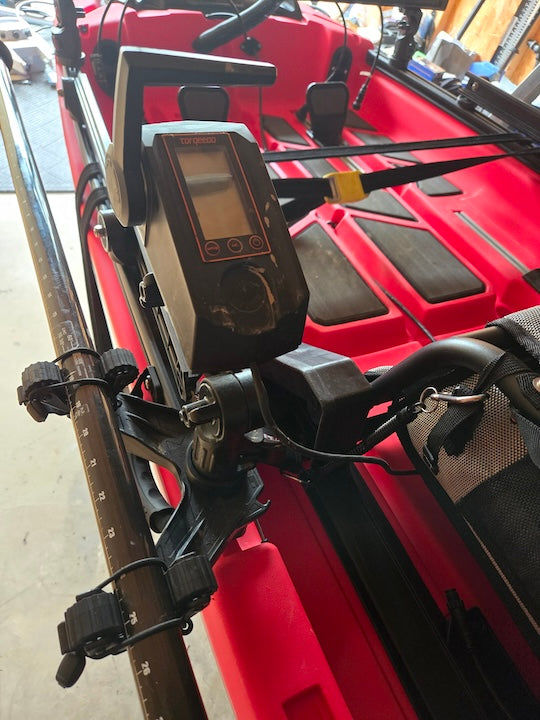
Joshua’s left-side rigging…
My dominant side is my right—that’s the side where I land my fish—so my paddle is on my left. I keep my net in front of me and angled to the right because when I land a fish, I’ll grab the net with my right hand and scoop over the right side of the kayak.
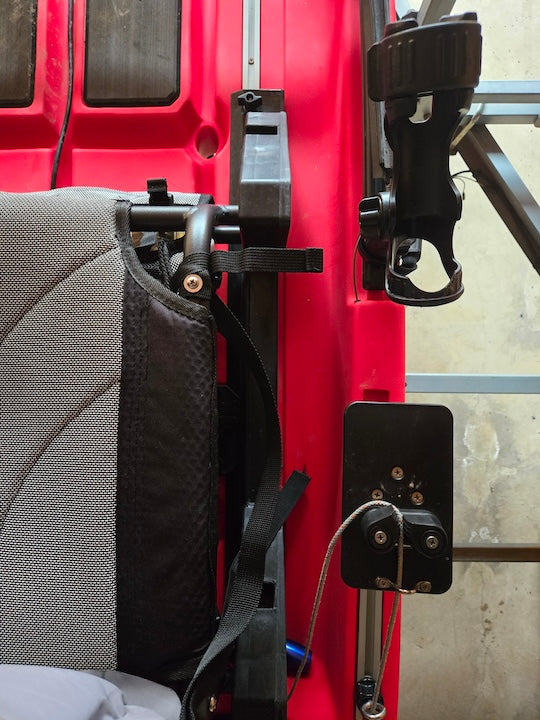
…and right-side rigging
The fish finder is centered right in front of me, not raised up too high. I can see it clearly but it doesn’t impede my ability to land fish, make casts or anything like that.
For anchoring, I use an Anchor Wizard. That’s on the left side of my cockpit, specifically because that’s my non-dominant hand. I can hold my fishing pole with my right hand and drop anchor with my left while I’m fighting a fish.
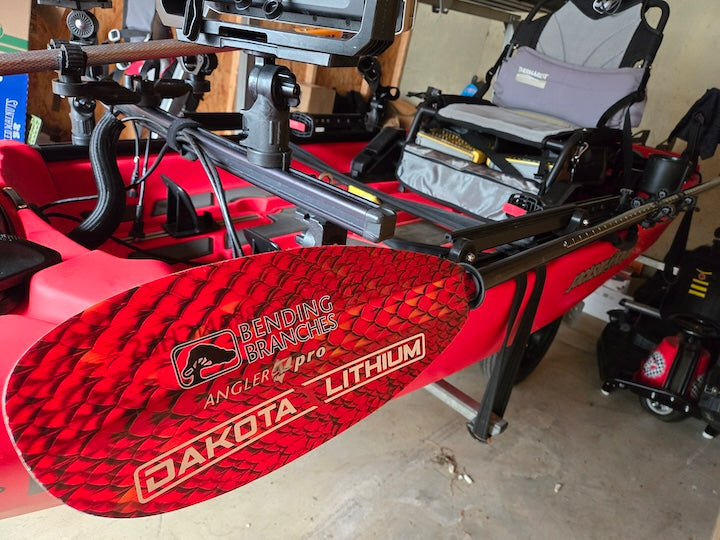
Sometimes during the big tournaments, anglers will have an overabundance of poles with them and an even amount on both sides. It looks pretty, but when you reach back you’re going to hook those rods. So I have three rods in holders on the crate itself and another three in holders installed on the track. All six are on my left so when I cast I’m not hooking anything. If I need one I can just turn around to my left and grab it, no problem. Again, it’s very functional and easy to access on the water.
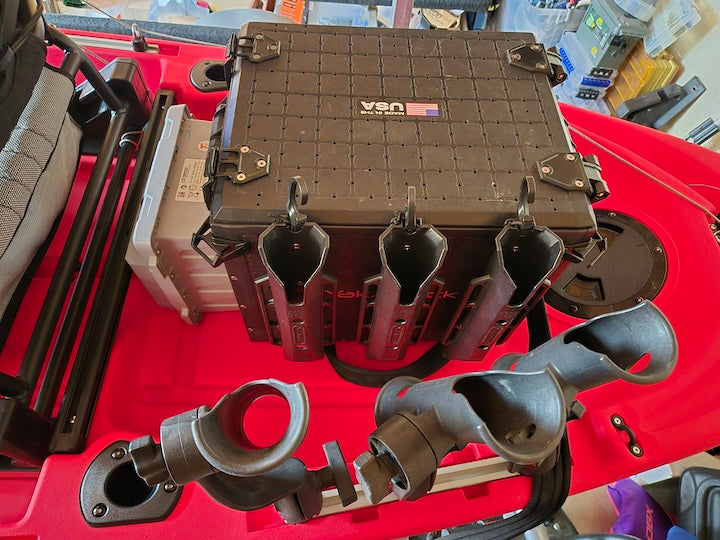
Joshua likes all six of his rod holders behind him on his left
For my motor, I have the throttle control on my non-dominant hand, on the left side. And I have the motor lift cord on the right-hand side, my dominant, stronger side.
I rig every single thing I use the same on any kayak I have because it’s what works for me. It’s all set up so I can use it optimally.
BRANCHES: How do you suggest new kayak anglers figure out their rigging?
JOSHUA: What I usually recommend for new anglers is that when they get a kayak, leave it completely bare bones at first, aside from the safety essentials and the paddle. Get out on the water a few times with it and get a feel for where you can reach on the boat comfortably. Find your personal radius.
Then really start to think about where you want to lay your stuff out. Bring a notepad with you and jot down ideas while you’re on the water because the best time to do that is when you’re sitting in your kayak. It helps to be there physically to visualize it all.
I know a lot of anglers like to take their kayak to a local dealer to do their rigging for them. They throw a pile of money down and walk away, then come back a week later and get their kayak on the water and wish things were in a different place. But a lot of times there are holes drilled in the boat and that piece is there.
So I recommend going out on the water a few times, take some notes, ask questions of seasoned folks. People are happy to help you out, including the Bending Branches team.
Then either buy the components and start rigging yourself or, if you don’t feel comfortable drilling into your own boat, take it to a reputable dealer that can rig it for you along with your notes. Be involved in the process and articulate why you want your components where.

A Therma-rest adds some comfortable back support for long days on the water
BRANCHES: What gear do beginning kayak anglers need the most?
JOSHUA: The kayak community can be very interesting—there’s a bit of the element of keeping up with the Joneses. You get to some of these events—the newer guys especially—and they see guys like myself who have a lot of the nicer gear and now they want it. So they go out and spend money without really knowing why. They don’t know where they’re going to put it or how they’re going to use it. They don’t know the benefit of that same piece of equipment you can spend $50 or $450 on.
So it’s very important, especially for the newer anglers, to take into account, “Do I need that or do I want that? How’s it going to enhance my ability to get out on the water and catch fish?” Because at the end of the day, that’s why we do it.
Then it’s, “Do I want my boat to look the prettiest when I pull up in the parking lot full of all the other anglers? Or do I care about actually being able to utilize this stuff comfortably?” Because a lot of times we spend anywhere from four to 12 hours on the water at a time.
First and foremost is safety—a personal flotation device (life jacket) and a Coast Guard-approved whistle that you keep attached to your PFD. Check with your state’s Department of Natural Resources to see what safety requirements your state has. You’ll need a light pole and flag for fishing tournaments.
Next is a good paddle. Bending Branches has a myriad of paddles from entry-level to top-end.
After that, it’s about your own needs. Some people are very minimalistic and don’t need to purchase anything because there are flush mount rod holders on the kayak. Other people want to go out and try a bunch of different techniques, buy a bunch of rods and bring a ton of tackle with them.
BRANCHES: Why is weight distribution important to keep in mind?
JOSHUA: This is especially important for folks who want a motor or a large, elaborate fish finder setup. All of that adds extra weight to your kayak. Kayak anglers need to know not only the weight capacity of their kayak but what distributing the weight does with their kayak.
If I take all the batteries I need for my motor, fishing finders and everything else and load them all in the back…take my own 275 pounds and my seat that’s pushed toward the back…now my kayak’s sitting with its nose out of the water. So what do I do to trim that out and balance it? A balanced kayak maneuvers best and optimizes performance when the weight is distributed evenly.
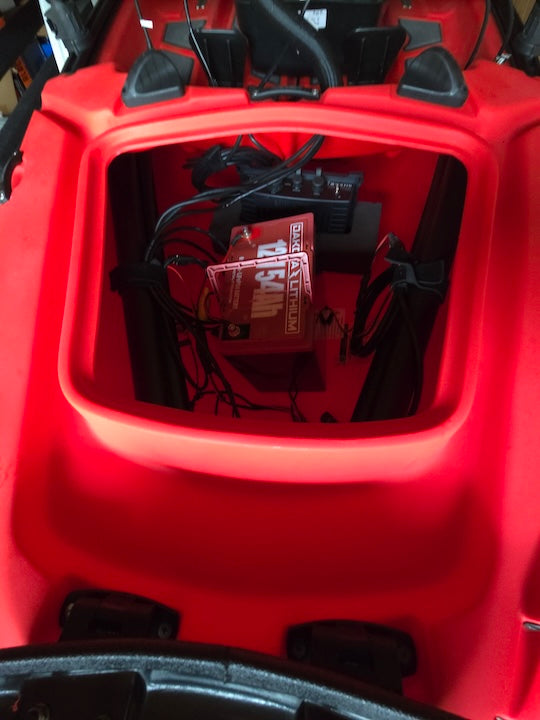
A couple of batteries in the front hatch to help distribute the weight evenly
It can be as simple as taking half your batteries and putting them in the front hatch, leaving the other half in the back. Then place your kayak seat in the optimal spot, the sweet spot. Now I also fish a lot of rivers and like to have my front end sitting up a little bit higher, so I’ll distribute my weight a little further back in those instances. But again, it’s something that should be considered.
BRANCHES: When did you make the change from your first cheap paddle to Bending Branches models?
JOSHUA: Like I said, when I got my first kayak I went to a big box store and bought a cheap paddle. It was probably aluminum with plastic blades. It was functional. But I would notice my hands would cramp up and be fatigued, and my shoulders would be fatigued from paddling during the day.
One day a fishing buddy mentioned they used a Bending Branches paddle and it was so much lighter. I didn’t think that would make a big difference, but said I’d try it. When I actually used one the difference was insane! I asked him if I could borrow it again for a whole day to really see how it felt. At the end of the day, my shoulders didn’t hurt. My hands weren’t cramped up. There wasn’t residue on my hands because of the coatings on cheap paddles.
Then there’s the shape of the blades that are tailored to efficiently push more water. They’re more lightweight so you can paddle longer and remain comfortable throughout the day. When we’re out on the water for those lengths of time you truly want to be able to enjoy that experience. If you’re sore and constantly stretch and pull on things, you can’t enjoy yourself to the same extent.
The Angler Pro Carbon is my absolute favorite. I can hold it on one finger it’s so light. That’s my river paddle because of being able to react and transition quickly with the lightweight. I use the fiberglass Angler Pro on big flatwater because the blade is just a hair larger. It helps me get bigger pushes on big water.

Joshua lands a fish during a tournament (photo by Karl Wynn, Tournament Director of Chesapeake Reel Masters)
A huge thanks to Joshua for sharing his expertise with us! You can see more from him on Instagram and Facebook.
All photos courtesy of Joshua Evans.
Do you have paddle questions our friendly Customer Service Team can help you with today? Contact us: 715-755-3405 • bbinfo@bendingbranches.com
More for you...










